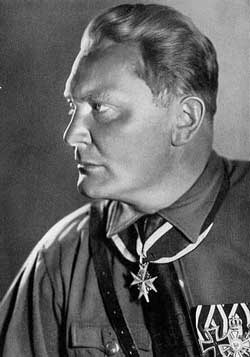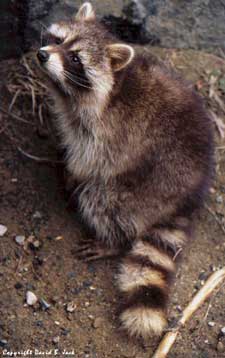|
 KASSEL
- The story goes that Nazi henchman Hermann Goering
imported a pair of raccoons from America in 1934 and
ordered them set free in the woods of central Germany to
"enrich the Reich's fauna", as he put it at the time. KASSEL
- The story goes that Nazi henchman Hermann Goering
imported a pair of raccoons from America in 1934 and
ordered them set free in the woods of central Germany to
"enrich the Reich's fauna", as he put it at the time.
In the 70 years since then, these "Nazi raccoons" have
multiplied in such prodigious numbers that there may be
upwards of a million of the rascally American mammals in
Germany alone - and they are spreading rapidly to
neighboring countries at an alarming rate.
So alarming is the spread of these nocturnal creatures,
who have no natural enemies in Europe, that officials
are considering drastic measures to cull them.
A stroll through Kassel, in the wooded hill country
north of Frankfurt, reveals a city under siege. It was
near here that that first coon couple was released, and
it is here that they are most populous.
Experts say there are 100 raccoons per square kilometer
in the Kassel area - the same density reported in the
raccoon's natural habitat in North America.
Residential homes in Kassel resemble fortresses, with
mesh wire covering all openings, spiked defenses on
downspouts and gutters. Even attic windows are barred.
Rubbish bins are secured with bungee cords or padlocks
in some cases.
 Tales
abound of how pies vanish from window sills where they
are left to cool - or even food from the stove top.
Nearly every family has seen glowing eyes staring in
through a window at night. Tales
abound of how pies vanish from window sills where they
are left to cool - or even food from the stove top.
Nearly every family has seen glowing eyes staring in
through a window at night.
One couple recently told how a raccoon slipped through
the cat-flap in the kitchen door and ate the pet cat's
food before retiring to a cozy cushion for a nap.
Folks in Kassel have even learned to put netting over
fruit trees to prevent rapacious raccoons from stealing
fruit.
Kassel is possibly the only city in the world to have
hired an animal control officer whose sole duty is to
patrol the streets in search of raccoons and answer
residents' appeals for help in ridding their attics and
back yard tool sheds of unwanted furry lodgers. He
drives a special vehicle marked "Der Waschbaermann"
(Raccoon Man).
The city has even paid zoologists from a nearby
university to tag and study raccoons in a bid to
determine the scope of the problem. The radio-beacon
tags permit researchers to follow the animals and learn
about their habits and population densities.
"Kassel is definitely the raccoon capital of Europe,"
says Ulf Hohmann, head of the raccoon study project.
"I'd say 50 per cent of the residents here have had
close encounters with raccoons, some of them on a
repeated or even regular basis."
 "Our
job is to educate the public about these marvelous
animals as we study their true impact on the European
environment," Hohmann says. "Our
job is to educate the public about these marvelous
animals as we study their true impact on the European
environment," Hohmann says.
The truth is that raccoons have over the past 70 years
spread throughout Germany. They are most concentrated in
the Kassel area and in an area east of Berlin, where a
dozen or more raccoons escaped from a fur farm in the
chaos of the waning days of World War II in 1945.
In eastern Germany the situation is so bad that local
authorities have proposed declaring open season on
raccoons and posting bounties for their pelts.
"Raccoons have become a pest and should be eradicated,
says Guenter Sachert, head of a hunting club in
Strausberg, east of Berlin. "I favor putting a bounty of
EUR 25 per pelt. They are, after all, not native to this
continent and are competing for food with foxes and
other native species. Something has to be done."
Others warn against exaggerating the raccoon menace.
"Foxes are more of a threat to chicken farmers than
raccoons are," says Matthias Freude, head of the
Brandenburg state agriculture department.
|